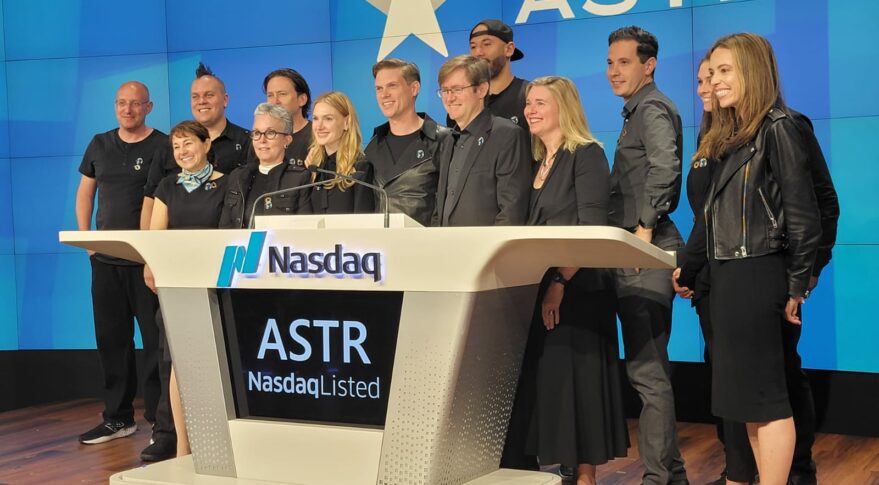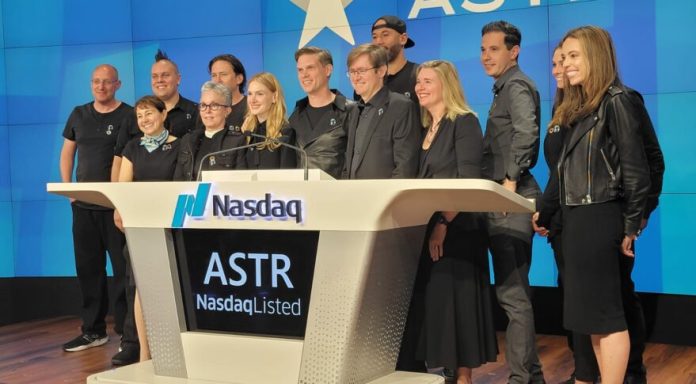
Astra completes first day as a public company ahead of launch ramp-up (Image Credit: SNN)
 100vw, 696px” data-lazy-src=”https://i0.wp.com/satellitenewsnetwork.com/wp-content/uploads/2021/07/Astra-team-1-879×485-1.jpeg?resize=696%2C384&is-pending-load=1#038;ssl=1″></a><figcaption id=) Astra became the second space company on July 1 to complete a SPAC merger this year. Credit: Astra
Astra became the second space company on July 1 to complete a SPAC merger this year. Credit: AstraTAMPA, Fla. — Astra’s shares closed up 4.5% to $12.90 July 1 after the launch vehicle developer’s first day on the Nasdaq stock exchange, which raised nearly $500 million ahead of its first commercial mission this summer.
The venture started trading on Nasdaq after merging with special-purpose acquisition company Holicity, whose shareholders approved the deal on June 30.
Astra’s mission this summer will be for the first of three undisclosed customers it has committed to launching in 2021.
Next year, the company now trading under the ASTR ticker has publicly committed to 15 launches as it works through 50 customers under contract.
The venture expects to be carrying out daily launches to low-Earth-orbit (LEO) by 2025.
“What is really starting to cause Astra to stand out from everyone else out there is our focus on scale,” Astra CEO Chris Kemp told SpaceNews in an interview.
“Not the scale of the rocket, but the scale of the factory and the scale of production and the number of launches.”
He said customers are willing to pay a lot more for responsiveness than “waiting six months or a year” for launches that could potentially face more delays.
Alameda, California-based Astra has been hiring former SpaceX employees that helped set up the Falcon 9 production line, as well as senior staff from Tesla from the Bay Area, to help scale up its factory facilities to meet this demand.
Benjamin Lyon, who spent more than two decades supporting the mass production of Apple products, including iPhones and iPads, joined Astra as chief engineer in February.
Astra anticipates unveiling its first customer when a launch date this summer for its upgraded Rocket 3.3 has been set. It will be its first launch since Rocket 3.2 fell just shy of reaching orbit in a Dec. 15 demo mission after running out of fuel early.
The startup has only disclosed one commercial customer so far: Earth-imaging venture Planet with a multi-launch agreement starting in 2022.
It has also announced two separate NASA contracts that call for launching multiple satellites from next year.
The 50 customers Astra has under contract are roughly split between commercial and government.
Under a deal Astra has reached with Nasdaq through 2025, Kemp said every Astra launch would be broadcast on a Time Square billboard in New York City to highlight its customer mission.
Successful SPAC
Astra announced plans on Feb. 2 to trade on Nasdaq by merging with Holicity, a blank check company run by cellular industry pioneer Craig McCaw that went public in August 2020.
Its listing comes a few months after satellite constellation developer AST SpaceMobile (ASTS) completed the space industry’s first SPAC merger of 2021, becoming a public company on April 7.
AST SpaceMobile’s stock closed up 1.8% to $11.81 at the end of its first day of trading, before gradually declining to close at $7.15 on April 19. The stock languished around that level before an upward trend that started at the beginning of June to close at $12.95 on July 1.
Six more space SPAC deals are slated to close this year.
However, the number of new SPAC deals has declined following increased scrutiny over how they operate.
New accounting guidance from the U.S. Securities and Exchange Commission (SEC) April 12, affecting how warrants that give investors the option to buy shares in the future should be listed in accounting books, threw a curveball at the SPAC trend.
Holicity had been preparing to file its accounting documents just as the new guidance hit, forcing it to pause the merger process for a couple of weeks to refile the paperwork.
The SPAC seeking to merge with in-space transportation company Momentus faces additional challenges, recently slashing the value of its deal in half amid security concerns and other issues.
However, Kemp said the SPAC process is still a good fit for capital-intensive companies in this industry, predicting “a whole wave of technology companies that are going to come out and create a whole new space sector that’s pure-play space.”
Scaling up
Astra’s SPAC merger proceeds will help scale up operations and expand its vertically integrated approach to space, which June 7 saw it acquire electric propulsion venture Apollo Fusion in a deal valued at up to $145 million.
Apollo Fusion thrusters will boost Astra’s move into the small satellite manufacturing business next year, enabling it to provide launch and space services beyond LEO.
Astra also plans to grow the payload capacity of its rockets from 50 kilograms to 500 kilograms, targeting growing demand from satellite mega-constellations.
Asked whether Astra’s vertically integrated strategy could lead to acquisitions outside of rockets and spacecraft, Kemp said: “Are we going to start laying fiber-optic cables under the ocean? I don’t see that coming. I think there are some great companies that have done that.
“I think that, in terms of building the infrastructure in space, vertically integrating that and building that is where Astra’s focus is, and so I think we’ll certainly look to partnerships on the ground with the leaders in the infrastructure needed to support what’s happening in space on the ground.”
Unlike launch providers SpaceX, Blue Origin, and Rocket Lab, Kemp said Astra will not develop systems capable of human spaceflight, saying this enables it to optimize technology for applications closer to Earth.
“We’re never going to Mars and that’s OK,” he added.
– Advertisement –









